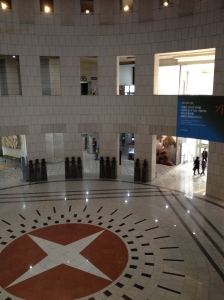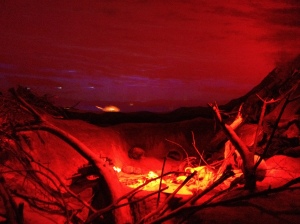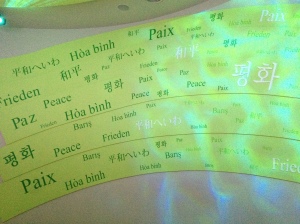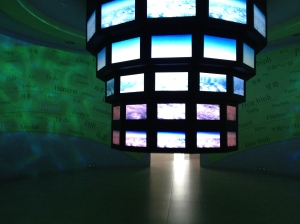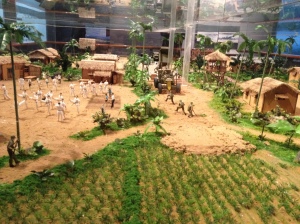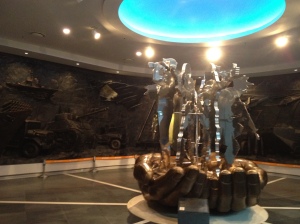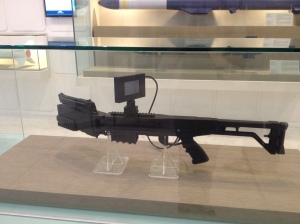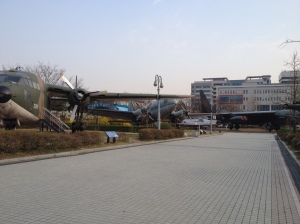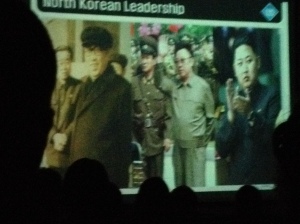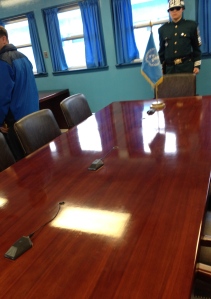The most affective and in many ways the most disturbing parts of the War Memorial are the second two floors. While the first floor contains exhibitions pertaining to ancient Korean warfare—the wounds of whose battles have mostly been healed by time—the second two floors are dedicated to telling the stories of wars that are much more recent and the fallout of which Korea is still greatly impacted by. The tone is set the moment you enter the first hall: the entrance to the first Korean War Room contains a wall made of video screens that shows a video of how the DMZ was established and some basic information about the Korean War. The floor is made of glass, and beneath your feet you can see a recreation of a grave, complete with skeleton, as though you’re gazing through the earth and into the resting places of the soldiers who were killed.
A good portion of the Korean War rooms are dedicated to evidence of Soviet and Chinese participation in the Korean Communists’ activities and the events leading up to the beginning of the war. This is a pretty important point, since today the North Korean regime continues to insist that the war was started by America and that the “imperialist” Americans continue to resist reunification. At the War Memorial you can actually see documents written from Stalin to Mao and Kim Il-Sung agreeing to back the Korean Communists’ aggression against then-President Syngman Rhee and agreeing to let China send forces into the peninsula to resist the United Nations forces. Of course, these documents are written in Russian, so there are touch-screen monitors nearby that provide translations in both Korean and English.
There are also displays of various kinds of vehicles and weapons that were provided for the Korean Communists by China and Russia, as well as weapons that were used by the South.
A lot of the rooms throughout this section of the museum are mini-theaters that show short educational films about various battles that occurred during the war and the stories of various units that fought in it. There are Korean versions of the films, as well as English and (if I remember correctly) Chinese and Japanese. In terms of educating people about the events of the war, I think the mini-theaters do an excellent job; as you move through the different rooms you’re told the same general history, but each room focuses on a different battle or topic. The repetition gives you a solid base of understanding about the overall events of the war, and the shift in focus makes it diverse enough to hold your interest.
There are also some pretty immersive elements to the Korean War rooms. At some points there are huge displays depicting battlefields, complete with the sounds of gunshots, explosions, and flashing lights.
Another display related to soldiers crossing a frozen river includes a pathway with screens on the floor. As you pass through the pathway you can hear the sounds of ice cracking, and when you look down at your feet the screens display images of breaking ice.
One of these types of displays includes an actual tank standing behind glass. When you enter the room you can press a button, after which text is displayed on the glass in front of the tank explaining the events of a battle at Seoul. As the text progresses, the tank’s turret suddenly jumps to life and starts moving, its gun sweeping from side to side as though searching for a target. Let me tell you, even if it’s behind glass, it’s pretty freaky being faced with the moving barrel of a tank’s gun.
There are also displays of various war heroes’ statues and communications between the United Nations officials in charge of aiding Korea. There are documents pertaining to General MacArthur, who convinced President Truman to allow him to take the whole Korean peninsula despite Truman’s fears that China would get involved once the conflict reached its borders. As it turns out the president was right, and MacArthur was subsequently relieved of duty.
One of the last areas in the Korean War rooms is dedicated to the families whose lives were affected by war. There are all kinds of images and videos of families grieving and orphans crying next to their parents’ bodies. It’s heartbreaking.
At the end of the War rooms you come upon what I’d describe as their thesis statement, a large structure constructed of video screens that hangs from the ceiling, playing footage from the war. The room is illumined with soft lighting that resembles the sun shining through water. To the right of the video monument there’s a mural painted on the wall with the word “peace” written in dozens of languages, and to the left a similar mural stands containing the word “freedom”.
If you live in Seoul, you could basically get university-level education about the Korean War just by spending time visiting the War Memorial. Between the videos and the explanatory text on the signs throughout, there’s more than enough information to fill a textbook. You could actually probably get a better educational experience, since there’s so much footage and there are so many artifacts from the events that occurred. What’s more, there’s no entrance fee, so you’d get all that education for free. It’s an amazing institution.
But of course, Korea’s military history doesn’t end with the Korean War. On the third floor of the museum there’s an area dedicated to the Vietnam War, which includes a tunnel-shaped entrance covered in bright green leaves. I suppose it’s meant to simulate the experience of entering Vietnam.
This area of the museum is smaller than some of the others, but it does include some video and light-up map displays, as well as a memorial statue, some war vehicles, and stunningly intricate models of Vietnamese posts.
After the area dedicated to the Vietnam War you come upon the women’s section, which commemorates all of the Korean women who have fought in the military and served as medical workers over the years. There are displays vintage magazines and news articles written about women in the military, some photos of their service, and even some ladies’ uniforms. Men in Korea are required to serve in the military for two years, but women are exempt from this service, so understandably this area is one of the smaller sections of the museum. I get the impression that the situation for woman in the Korean military isn’t much better than it is in Canada or other countries.
After that you move on to the modern war area, which is kind of cool and exciting and kind of depressing. You can see a lot of things that you wouldn’t otherwise have access to, like missiles, models of modern war vehicles, and life-size simulations of submarine cockpits.
Some of the more interesting displays include the “Future Warrior” combat suit, a full suit of modern combat armor that looks like something out of Robocop. There’s also a rifle with a flexible tip and a little screen mounted on top of it that lets the gun operator fire around a corner without exposing him or herself. I’m not going to lie, my first reaction on seeing this stuff was something along the lines of, “wow, that’s pretty cool!”, but then of course it just reminded me that this is the kind of gear that will only ever be used during wars like the ones in the rooms I just visited. There’s nothing really cool about that.
The last of the more impactful areas of the museum are the Memorial Hall dedicated to the Korean War heroes and a secondary memorial hall dedicated to the UN forces who sacrificed their lives fighting for Korea’s freedom. The Memorial hall is breathtaking. It’s comprised of several rooms, the last of which is called “Creation”. “Creation” is a large, circular space with a pool of water set into the ground. A ring of three stone steps leads down into the pool, and an enormous, black stone bowl that’s nearly as tall as I am stands in the center of the pool. A ray of sunlight shines down from the ceiling into the bowl, which is filled with water. The sunlight is meant to represent Korea, while the bowl represents creation and the “everlasting Korean nation”. If nothing else in the museum tips you off, it’s at this point that a touch of Korean nationalism becomes pretty clear. Still, it’s a fantastic piece of architectural artwork.
In the UN memorial hall there are displays containing armor and weaponry from various countries that fought against the communist Koreans during the war, as well some video displays and other exhibitions. There’s also a large monument that’s mounted on the ceiling of one of the rooms and resembles a series of rings comprised of military tags. Instead of names and ranks, though, they contain photos of individuals who contributed in significant ways to the war effort.
That basically covers the interior of the museum, but there are also some interesting sights standing on War Memorial grounds. Row after row of decommissioned military, naval, and air force vehicles are displayed for passersby to see, and while you can’t climb into them you can get close enough to touch them. It was pretty amazing seeing some of these things in real life for the first time. They’ve got bombers, gunships, mechanized infantry, artillery, tanks, and many, many other vehicles. There’s nothing like touching the shaft of a machine gun mounted on a helicopter gunship to make history come alive.
Overall, I was really impressed with the National War Memorial in a number of ways. In terms of educating both Koreans and international visitors it’s extremely effective, and the layout makes it easy to spend hours inside while feeling neither bored by the wealth of inform nor overwhelmed by the horrors of what occurred. It’s extremely sobering but doesn’t feel particularly manipulative. I was also pretty impressed with the consistently high-tech displays, which really brought the events of Korea’s history to life in creative and dynamic ways.
A few points did seem kind of strange to me, such as the nationalistic undertones that sometimes crept up in displays, and the gift shop that had things like key chains with guns on them and models of military vehicles that kids can construct. There’s also a “shooting area” where kids can fire model guns in a simulated environment, and a digital photo booth where you can get pictures taken standing in front of green screens of various military vehicles as though you’re a soldier. You can even have your face superimposed onto a soldier’s body.
I can’t help but wonder what the point of these aspects of the museum is: is it just something to hold the kids’ interest? I can’t deny that if I were eight years old I probably would have been either completely overwhelmed or bored out of my skull by all the military history. Or is it a way of alleviating the fears of young boys who will one day serve in the Korean military? Since service is required of every man in South Korea, I imagine seeing the displays of the modern wars Korea has been involved in might make little boys a little less enthusiastic about their mandatory service. Is it a propaganda tool to get little boys eager to serve their country? Or has the reality and urgency of war in Korea simply become so much a part of the culture since the 1950s that it’s met with much more of a blasé attitude in people’s day-to-day lives than it is in Canada, where the threat of war never seems particularly present?
Well, obviously I don’t know enough to actually be able to answer any of these questions, but the War Memorial definitely left me with a thirst to know more.
